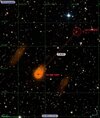palestine
Jedi Council Member
A. Lobaczewski speaks of "schizoïds" who are people affected by a mild (probably DNA based) anomaly. He explains that during specific times of relative calm, schizoïds tend to come up public with "ideas" who find an echo in society. What happens then is that it gives birth to a pathocracy, a long process during which the schizoïd and his ideas are gradually discarded in favour of a basic STS agenda. Is this what happened with Bacon and Rosicrucians? From your knowledge of Bacon, was he more a kind of guy who wouldn't know that his manifesto was that wrong? Or a real bad guy? If the latter, the whole schizoïd appraoch would not apply.As I have written elsewhere, this supernova had a profound effect on the young Sir Francis Bacon who was probably the person who wrote the Rosicrucian Manifesto referred to in the session above. Even as a young boy, he took the supernova as a sign, an augury or an omen, to launch what he saw as his 'Great Work' to restore western civilisation to the heights it once occupied.
By the way, I wonder whether Sir Francis Bacon might be another candidate as an undergrounder and a 'Deep Level Punctuator'. He rose from relative obscurity to become Lord Chancellor of England and was one of the main drivers in the creation of the British Empire which really started with the fledgling American colony of Virginia for which he, as secretary to the Virginia Company, would write the colony's constitution that would later greatly influence the drafting of the US Constitution. Many people also think that he may have been the Grand Master of the early 17th century Rosicrucians, an underground movement and brotherhood which had a great effect on the late Renaissance and heavily inspired the Enlightenment as well as the launch of the modern scientific age, Bacon being one of the founders of the modern scientific method. Finally, he was most likely the real writer or pen behind the plays of William Shakespeare that helped to create modern drama as we known it today and are amongst the most influential written works of the last millennia. On this basis you could argue that he was more influential in the long term than Sargon the Great, Queen Nefertiti, Mayer Amschel Rothschild and even Napoleon Bonaparte if he was indeed an undergrounder and a Deep Level Punctuator. Moreover, did he really die in 1626 as claimed or did he go underground with his fellow alchemists in that mysterious enclave in the Pyrenees?
In addition, I can see a very interesting point: Bacon sees a comet, and he writes his manifesto. I posted, the other day, about the idea of comets as "information flux", rather than "a simple rock" (so, a comet polarity would vary, from a negative information flux to positive). But this is high speculation on my part. Could be that a comet was carrying very negative ideas and that this is what influenced Bacon. As a schizoïd, his DNA-bit would have acted as a tuning receptor for the data - and he wrote the manifesto in turns. This would explain "Bacon was very impressed by the supernovae... and ...". Idea here would be that schizoïds such as Marx, and others who really wrote the big ideologies turning pathocracy - had a comet right in front of their eyes, at some point in time. Could be that those comets were of the family of "negative comets". A catalyst. The specific bit of A. Lobaczewski goes by "during stable times, schioïds believe they found a way to fix the world"; they would "come public" and "tell others". What if there was a trigger for this?
This could be a missing link in A. Lobaczewski's theory? He basically explains that "there exist schizoïds", that "those have deviant ideas", "are manifesto specialists" - and that "their negative potential is set in motion during stable times". As of now, those guys are simply "popping up with ideas". But those ideas give birth to things that are so negative... It becomes odd. The matter with schizoïds is that they are not 100% bad guys; as A. Lobaczewski explains, they are carriers of an anomaly, but they are "torn down between the world of normal people and the feeling for psychopathology/STS". They are far from being essential psychopaths. And so, it's still with them that the worst periods of history start. Was Bacon a schizoïd?



 .
.



